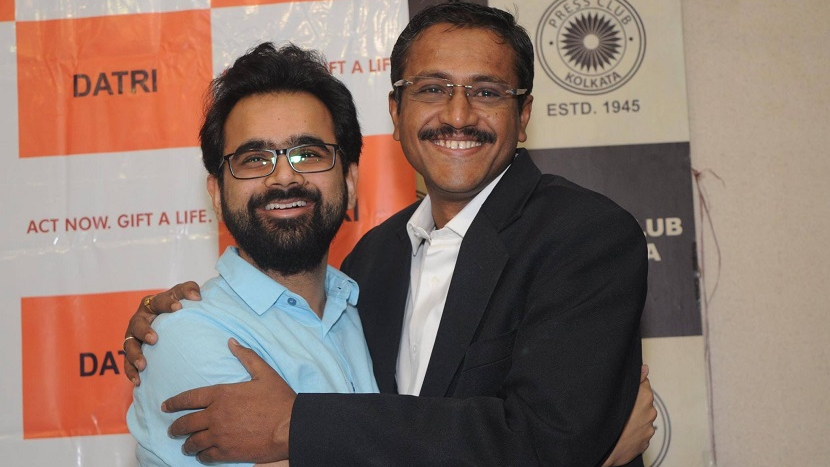
Sajat Jain (left) with Nilesh Sinha
On a balmy morning, three years back, Nilesh Sinha, 43, saw a blister on his tongue, the kind one gets during indigestion, but it was redder than usual. He went to a neighbourhood clinic and the doctor advised him to go for a simple blood test.
The blood report revealed that his platelet count was low, a mere 18,000 which further dropped to 8,000 by the next morning, even after undergoing a platelet transfusion.
After ruling out the usual suspect, dengue, the doctors moved to more complex diagnosis, tried various blood tests, bone marrow test for over a month, but could not reach any conclusion.
A month later, he was diagnosed with Aplastic anaemia, a rare disease in which the body’s bone marrow stops producing red and white blood cells, platelets, and the body's own immune cells attack the blood cells.
The doctor immediately put him on anti-thymocyte globulin (ATG), an infusion of a horse or rabbit-derived antibodies against human T-cells. It was to weaken the immune system of the body to an extent that it cannot attack its own cells. "I had never visited a hospital in my 39 years, so my disease came to me as a shock. I shed all my body hair due to ATG, my skin colour became dark like char. I felt drained most of the time," he says.
The disease relapsed after a few months and doctors told Nilesh that a stem cell transplant was his only chance. "They told me that even with a stem cell transplant, I had only 30 percent survival chance," he says.
Nonetheless, I was ready to take the risk but I needed a donor. I contacted John Hopkins Hospital in the US and King’s College in London, the two world famous centres known for their expertise in treating Aplastic Anemia. But they told me only an ethnic Indian donor match can help me. I was referred to Dr Mammen Chandy in Kolkata.
We looked for a donor through the stem cell registry called Datri. I got nine donors match; the doctors shortlisted two. I and the donor both had to be what they call 'conditioned' before the surgery.
Nilesh had to undergo ATG again, a higher dose than before to kill all the blood cells. The idea was to remove all the cells so that they could not attack the new donor's cells after the transplant.
The donor, too, had to take some injections for five days to stimulate the bone marrow to produce and release a lot of stem cells into the peripheral blood. The two of us had to be treated simultaneously.
However, on the second day, the donor backed out. He disappeared.
The doctors panicked because ATG could be fatal without a donor ready to give the fresh stem cells. "I went blank for a moment. I didn't know what to do. My sister offered to donate her stem cells, but we were only 60 per cent match and chances of rejection were high," says Nilesh
Datri contacted another donor in Delhi.
Sajat Jain, a young IT professional had registered as a donor just six months back. "I was doing some online research for my own health start-up when I came across Datri. I don't know why, but I got particularly fascinated by the whole process of stem cell donations registered as a donor," says Sajat.
He was told how desperately this 42-years-old man in Kolkata, who was suffering from Aplastic anaemia needed stem cells and he is a match. Nilesh's name and other details were kept private. “The caller described the process of donation to me. The process was similar to platelet donation but I had to take these injections, the only side-effect could be mild body aches," says Sajat.
Sajat's father called up their family physician to get more details on the process and its consequences before Sajat donated his stem cells in a private hospital in Delhi.
A year later, Sajat met Nilesh in Kolkata. He knew nothing about Nilesh except his name and age till then. He was eager to meet him. It was Nilesh, who spotted him, he hugged Sajat tightly. His mother, standing next to him, had tears in her eyes.
"It was nothing, just a mild body ache that I generally suffer when I have cold and a prick for five consecutive days for me. I am so happy I have been able to save a father of two little children. I cannot describe how I felt that day," says Sajat.
“My blood group was B positive and now it is that of Sajat's, AB+. We are truly blood brothers,” says Nilesh.